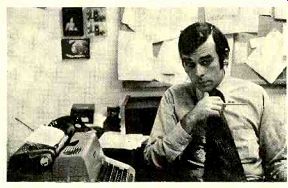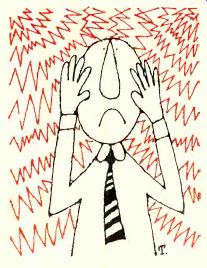
by Ralph Hodges
POWER: HOW MUCH DO YOU NEED?
-----
As George Tlamsa points out in his survey of receivers in this issue, amplifier power accounts for the lion's share of the cost of a typical unit. Therefore, before buying, you ought to assess your power requirements as realistically as possible. The receiver article offers some rough general guidelines to start you on your way, but they cannot be followed blindly and without reservation because, un fortunately, they require some adjustment to fit each individual case.
One of the important aspects of intelligent sound-system design is planning ahead for certain eventualities. Crowding forty people into your living room for some dancing means that you're going to need appreciably more amplifier power than the guidelines might lead you to expect (great sound absorbers, people). On the other hand, if you don't boogie and you avoid entertaining guests who do, you're okay-that is, until you decide to take your speakers out onto the patio to regale your garden party with a little Stan Kenton.

Assuming typical speaker efficiencies and typical receiver powers, a very little Stan Kenton is exactly what you'll get. In the great out doors, even the New York Philharmonic can not generate a sound level high enough at listeners' ears to make an unamplified outdoor concert worth giving. These are all things to be aware of as you plan a sound system around intended applications. And there are plenty more.
Over the years, STEREO REVIEW'S test reports have featured any number of speaker systems that will produce a sound-pressure level of 90 decibels (dB) at a distance of 1 meter when driven with 1 watt of amplifier power. Some simple calculations tell us that such a speaker should theoretically be capable of producing 106 dB (again, at 1 meter) when driven with 40 watts of power. Seems very respectable, doesn't it? Well, let's look (listen) a bit more closely.
First of all, just how loud is 90 dB anyway? As it turns out, this really depends on those you ask and what they're listening to. For most people, 90 dB sounds considerably less loud at 60 Hz than at 6,000 Hz; this is because of the ear's relative insensitivity to low frequencies. But skipping over that point, let's ask the easy-listening-music enthusiast how loud 90 dB is. Given his (typically) rather highly compressed recordings (which means that dynamic levels are never allowed to fall much below 90 dB) and his general idea of what a satisfactory music experience is, it's likely he'll reply that 90 dB is certainly loud enough and frequently a bit louder than he'd really like. But then ask the symphonic listener gleefully reveling in, say, Stravinsky's Le Sacre du Printemps and you'll probably find that 90 dB, although a passable level for unaccompanied strings, just doesn't make it for the closing minutes of the Sacrificial Dance.
Would he be able to tolerate 106 dB on the loudest peaks at his ear? He would have to be made of pretty stern stuff, but such levels in the home are not unheard of.
However, before we can begin talking about 106 dB, we have to bring in another as yet unexamined factor: the 1-meter distance at which the sound-pressure-level measurement was made. We don't usually listen to loudspeakers at a distance of 3.3 feet--10 to 12 feet is more the rule in smaller rooms, with greater distances common (and usually preferred) in larger spaces. Using a variety of test tones and program material, I recently measured losses in sound-pressure level of between 6 and 14 dB when the test micro phone was moved from a 1-meter position to a point about 12 feet from the speaker. (This was in a small listening room of typical pro portions; I would attribute the 8-dB variation to room modes--its resonances, that is--and the dispersion characteristics of the speaker used.) In this case, if we're looking for 106-dB peaks at the 12-foot distance, we'd need at least 160 watts to drive that same loudspeaker, assuming the average loss is only 6 dB. Of course, peaks of 100 dB are still theoretically possible with 40 watts of power. This is roughly what you'd measure in the back of a large concert hall with a full symphony orchestra going just as hard as it could; fairly loud, in other words, but nowhere near enough to provoke the use of ear plugs. With the close-up microphone perspectives used in many symphonic recordings, 100 db maximum would probably not allow enough re serve for fully realistic levels on orchestral peaks without audible distortion.
The moral is that your power requirements for a home audio system are going to depend enormously on your individual listening preferences and practices. In 1964 Harry F. Olson reported that, on the average, home listeners preferred a maximum level of 70 to 90 dB. It is probably safe to say that 70 dB would seem very soft to most listeners today, and thus it's probable that the preference level is creeping up. Without question, the popularity of high fidelity sound equipment has played its part in this rise. I would estimate that the proud new owner of a high-fidelity system immediately takes a 10-dB jump in level over what he had adopted for his previous low-fi equipment, and that's a tenfold increase in amplifier power requirements even before speaker efficiency is considered.
So, with the (fairly typical) speaker we've been using as an example, a small and rather live listening room, and 1 watt of amplifier power, you should be able to achieve levels of at least 84 dB-right in the average-level ball park, at least for 1964. Four watts of power will get you up to 90 dB, which might be considered the barest minimum for anyone interested enough in sound reproduction to be reading this. To get to 100 dB-within striking distance of realistic concert-hall peak levels, but with no reserve to spare-you'll need 40 watts. And beyond that there is a break point at which even phenomenal power increases bring less and less peak-level reserve: 80 watts for 103 dB, 160 watts for 106 dB, 320 watts for 109 dB, and so on. Incidentally, these requirements are somewhat above what you'd calculate from the graphs accompanying this month's cover story, "Receivers Today" (see page 68). This is because they are based on real measurements rather than "average-case" estimates.
Most serious home listeners of my acquaintance aim for a peak-level capability between 103 and 110 dB. You'll note that the power requirements for these two levels are vastly different. You'll also note that for each 3-dB increment of increase-a barely significant increase of level to the ear-a doubling of amplifier power is involved. This poses a dilemma to the audiophile, because each tiny twitch of the volume, control requires many, many more watts. And this is why, at audiophile listening levels, the question of how much power is enough provokes such serious concern. In any event, it's clearly a question each listener must answer for himself.
Also see:
Source: Stereo Review (USA magazine)